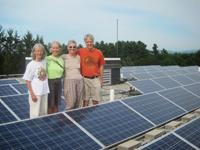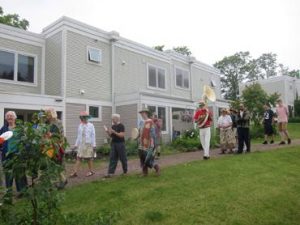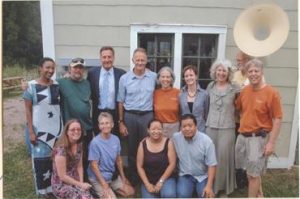By Don Schramm

Burlington Cohousing Solar LLC members Charlotte, Barbara, Joan, and Don in front of some of the 113 panels that provide power to the community’s common circuit.
Cohousing in Burlington, Vermont had a long incubation period. We moved into Burlington Cohousing East Village in November 2007 after working towards it for 18 years. It felt like a Phoenix constantly arising from the ashes. Along the way we developed an in-depth mission statement that gave higher priority to affordable housing and engaged residents than to energy-efficiency and environmentally friendly power. While we tried to include passive solar, living roofs, tight and highly insulated structures, sustainable materials, and solar panels in our designs, our budget limited us to no living roofs and only conduits for future solar power. Since move-in, Burlington Electric Department and the State of Vermont have initiated a number of solar programs with incentives. As we have been weaving our way through our processes to get to a smaller environmental footprint, they have been stumbling their way through their processes as well.
East Village has enthusiastically embraced solar power after a number of skirmishes about private use of our common areas. Our physical community consists of a barn, two single family homes, 10 townhouses, a duplex, and 18 flats in the main building which also holds the common kitchen, dining room, living room, and guest bedrooms. All of these buildings have flat roofs except for the single family homes and our barn. We now have 175 solar panels providing 70 percent of our common use electricity and monthly credits on the electric bills of 11 of our 32 families. Of these panels, 83 are on the main building roof, 30 on the barn roof, 14 on one townhouse, and 16 each on three townhouse roofs. There are likely more solar panels to come and the issue of “private use of public areas” is still a hot one.
This issue grew gradually. When we moved into our newly built housing, we had exhausted our construction budget and there were many important features missing from our community. So the next two years we were busy repairing the 1940s barn that came with the land, building parking sheds, adding roof decks, creating guest rooms, furnishing the common kitchen, dining room, and living room, and many other smaller projects. We accomplished a great deal but at the same time glossed over some of the processes involved.
In the fall of 2009, two different families requested permission to install solar panels on the townhouse roofs above their heads. Both were approved by the Owners Association. The first family sailed through the process but ended up lacking the financing. The second family met some objections—first from several people unhappy overlooking their solar panels and second from owners concerned that eventually the community as a whole may want to use that roof for general solar power. That project went forward with the stipulation that in case the community wants our general solar system to be combined with those on this single townhouse, the owner would add her panels to the plan at no extra cost to her. Soon afterward 14 solar panels went up on her townhouse roof. This system used a single inverter and a set of storage batteries. Any power generated beyond what was used or could go into the batteries went out onto the electric grid.
At that stage our community began to confront conflicts that boiled down to individuals or families requesting some private use of public areas—in many cases roof space. A task force began brainstorming how to deal with such conflicts. There was unanimous agreement that the community as a whole owned all the buildings’ “skins” and roofs. If we as a community agreed to use the space for everyone’s benefit, there was no conflict. For example, we built a deck out over the third floor roof for community relaxation and gardens. That was a case of public use of public areas. When some families wanted to put air conditioner condensers on that deck then we had an issue. Those were eventually resolved by putting the condensers on the uppermost roof one story higher.
In August 2010 a consortium of three owners proposed installing 113 solar panels on the main roof and south barn roof. Other residents could have joined the consortium but chose not to. It would have been better if the Owners Association itself could have taken on this project but it did not qualify for the federal solar tax grants which was 30 percent of our total costs. So we formed the Burlington Cohousing Solar LLC which would finance and organize the project and sell the power to the Owners Association. Now the questions began to fly. Would the panels damage the roof and if so who would pay for the repairs? Would they be insured and who would pay for that? How much would the fourth floor residents be disturbed by the installation? Were we truly being ecologically responsible in buying solar panels manufactured in other countries using resources and energy to ship them? The Solar LLC followed the new procedures for “private use of public areas,” answered all the questions thrown at them, and started the installation that Fall.
While this was a “private use” in the sense that three solar LLC partners would get a return on their investment, it appeared to be for the overall good of the entire community. The majority of our common electric power would now come from solar. Our electricity rate would remain stable. In fact it ultimately went down $2,000 a year because our lower power purchases dropped us into a lower rate category. The Owners Association has the option of buying out the investors at a set cost anytime after the first five years. Through this process our Solar LLC had the assistance of Community Energy Exchange, an L3C organization which facilitates the development of community energy projects in Vermont. They helped design the system, choose the installer, set up the LLC, and do the general administration. In return they were given a small ownership stake.
The installer, Vermont Solar LLC, suggested that we use micro-inverters on each panel rather than a couple of inverters for the entire system. With micro-inverters, a problem with one panel will not impact the total electrical output of the entire array. Also micro-inverters are connected to the internet and the status of any panel can be assessed online. There were some risks to this approach because micro-inverters did not have an established track record. Many of them actually failed on our main roof before the manufacturer decided that we had a gotten a batch of lemons and had the installer swap them out for newer versions. That was a year ago and we have had no failures since. Unlike the first solar installation with a battery backup, this one simply used the electric grid for “storage.”
During the installation, we had a misunderstanding. A couple of residents lost their parking spaces when the crane arrived. They were upset enough that the crane had to be sent back while we resolved the dispute by providing more information and apologizing profusely. We had neglected to keep our neighbors fully informed of the details of what was going to happen. There was some peripheral “heat” around the issue that our conflict resolution committee helped ameliorate. The 113 solar panels have now been in operation for almost three years and have produced about 90 megawatt hours of power equivalent to offsetting 62.2 tons of carbon.
With this amazing success, one would expect clear sailing with the next solar project. That was not to be the case. In the spring of 2012 Burlington Electric Department opened a new solar program—Group Net Metering. This program enabled any resident of Burlington to install solar panels anywhere within the City and get credit on their electric bill based on how much electricity was produced by their panels. Ten families in East Village decided to give this idea a go. We estimated that after applying the Vermont Solar Incentive and the Federal Tax Credits, our per panel cost would be about $800 and each panel would provide $50 to $55 of credit each year. Various families would be purchasing different numbers of panels based generally on how much electricity they used. Together we would be installing 48 panels on two or three townhouse roofs.
“Which roofs?” seemed to be the major question. There are three blocks of townhouses that could handle solar panels. The duplex could take 40 altogether. One five-townhouse block could take 80. The other could take 64. We asked the townhouse owners how they felt about solar panels going on the roofs above their heads. One said she could not afford solar panels now but was planning to install them on the roof above her in the future and did not want to lose this opportunity. Another said they wanted to put a stairway up to their roof and sunbathe on it. Interestingly this family was one of those purchasing solar panels. A third owner said that she did not want solar panels on her roof. Four owners were supportive of having solar panels on the roofs above them. No one claimed that they owned their “roof” but there was a strong feeling that they should have some say about what happened up there.
Underneath the question of “Which roofs” were deeper questions. When is it appropriate to allow the “private use” of our “public areas”? For what purposes would we allow “private use” and how do we decide? Our task force had worked out a thoughtful procedure for residents to follow when requesting their “private use of public areas” and that was helpful when some residents wanted to build a stone wall and others to put in various types of sunshades. But the procedure did not go far enough. In retrospect we began to realize that we should never have agreed to the earliest proposals from residents to install their own solar panels without fully developing a policy for the “private use of public areas.” The large solar project went through relatively easily because everyone seem to benefit from it. It too should have waited for policy development.
We were getting close to the deadline for the Vermont Solar Incentive, so we put off the full debate as to how we decide on what happens on our roofs. With three owners in one five-townhouse complex willing, we decided to put the panels there. We followed the “private use of public areas” procedures and got approval from the Owners Association to move forward with the installation with the stipulation that exactly which roofs the panels would be installed on would follow a community forum on the use of our roofs.
Nineteen people showed up for the forum and the discussion was lively. This was clearly a case of “private use of public areas” because the electrical credits generated by the new solar panels would only go to 10 of our 32 families. Nevertheless the project fit well our mission “to actively co-create and sustain a neighborhood that is nurturing to people and nature.” Our hope too was that we would find the means in the future for the other 21 families to participate in group net metering and then the benefit would be community-wide. Some folks want energy independence similar to the first solar project that went in. That owner uses batteries to store power to use at night or when an outage occurs. Some suggested that a mix of energy independence for some households and group net metering for others might work best.
Questions were raised about conflicts of interest among the residents who would own the new panels. Should they be involved in the Owners Association’s decision as to whether to go ahead? With our consensus-based decision process, conflicts of interest may possibly be less relevant because not just a majority but everyone needs to be on board. Is there a way residents can have some say in the decision as to what happens over their heads—at least if there will be serious disruption of their lives during installation or ongoing? The group net metering project sputtered its way through probably because “enough” of our residents seem to benefit. The 48 solar panels were installed in late Fall 2012 and started producing power in January of this year. Each month 10 families see a credit on their electric bills.
There is a move afoot to expand group net metering so that every family that wants to can participate and those who want to add more panels will be able to. Burlington Electric even has a program now of low-interest loans tied to property taxes that will cost less each year than the savings on electric bills. This time though, the community seems to want a thorough thrashing out of the issues around “private use of public areas.” This seems to be a debate about competing private uses of common areas. Although photovoltaics may be in keeping with our mission statement, we need not conflate “in the interest of the community” with “undertaken by the community.” Essentially if it is not the Owners Association doing and owning a project, then we still only have one private use vs. another private use.
It is unlikely now that further solar panels will go up in our community unless we develop together a plan for a full build-out that all families will participate in. Perhaps we have to devise a method whereby individuals can invest and their financial interests will be protected but the community as a whole will own the panels. The discussion about how this might happen is planned for this Fall and it is likely to be a lively one.
Burlington Cohousing Common Circuit 25.4 kW Solar Project
Expected First Year Energy Production: 31.450 MWh
Developer: Burlington Cohousing Solar LLC with help from Community Energy Exchange L3C
Installer: Vermont Solar LLC, www.vtsolar.com
113 Solon 225W Photovoltaic Modules with Enphase M215 Inverters
Total System Cost: $144,864.00
Less Federal Grant: $43,459.00
Less State Incentives: $24,069.00
Net Cost: $77,336.00
Cost per Solar Panel: $684.39
Cost per installed kW: $3,044.72
To view system go to: enlighten.enphaseenergy.com/public/systems/gyBG12559
Burlington Cohousing Group Net Metering 11.52 kW Solar Project
Expected First Year Energy Production: 13.868 MWh
Developer: Burlington Cohousing Net Metering Group with help from Community Energy Exchange L3C
Installer: Vermont Solar LLC, www.vtsolar.com
48 Solarworld SW240 W Photovoltaic Modules with Enphase M215 Inverters
Total System Cost: $57,610.00
Less State Incentives: $6,912.00
Less Federal Tax Credits: $15,210.00
Net Cost: $35,488.00
Cost per Solar Panel: $739.33
Cost per installed kW: $3,080.56
To view system go to: enlighten.enphaseenergy.com/public/systems/3wpF144878
Anyone wishing copies of the following documents—
A – Solar LLC Operating Agreement
B – Solar LLC Power Purchase Agreement with Burlington Cohousing
C – Net Metering Group Agreement
D – Solar Equipment Hosting Agreement
—may email noah [AT] communityenergyexchange.com.
Excerpted from the Winter 2013 edition of Communities (#161), “Renewable Energy.”



